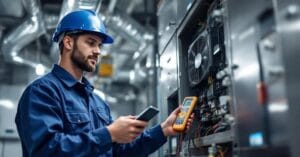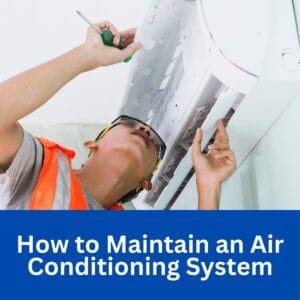

Staying cool during hot weather isn’t just about owning a good air conditioning system—it’s about keeping it in top shape. Regular maintenance doesn’t just improve your air conditioner’s cooling efficiency, it can also cut down on energy consumption, reduce your energy bills, and keep your indoor air clean and comfortable. With proper care, your air conditioning system can provide a constant, comfortable indoor temperature regardless of outdoor conditions. Whether you use central air conditioners, heat pumps, or room units, maintaining your cooling systems properly ensures long-term performance and comfort.
To maintain your system effectively, it’s essential to understand how it works. Most cooling systems include key components such as the evaporator coil, condenser coil, compressor, duct system, and air filters. These elements work together through a process called the refrigeration cycle, which moves heat from inside to outside. This process is designed to deliver cold air and maintain comfortable indoor temperatures by drawing in outside air, cooling it, and distributing cool air throughout your home via the indoor unit and ductwork.
Central systems cool the entire house, using chilled water or refrigerant that is pumped through the system to distribute cool air efficiently. Window units and split systems cool individual rooms and are typically installed in a window frame or through a wall opening. In split systems, the indoor unit is often mounted on a wall for efficient cooling. Heat pumps offer both heating and cooling capabilities, making them versatile options for year-round comfort.
When it comes to keeping your home comfortable, there are several types of air conditioning systems to choose from, each designed to meet different needs and spaces. The most common option is the central air conditioner, which uses a network of ducts to circulate cool air throughout your entire home. This system is ideal for larger houses and provides consistent cooling in every room.
Heat pumps are another popular choice, offering both cooling in the summer and heating in the winter by reversing the flow of refrigerant. This makes heat pumps a versatile and energy-efficient solution for year-round comfort.
For homes without existing ductwork or for additions where installing ducts isn’t practical, ductless mini-split systems are a highly efficient alternative. These systems consist of an outdoor unit connected to one or more indoor units via a refrigerant line, allowing you to cool specific rooms or zones independently.
If you need to cool a single room, window units are a self-contained option that fit directly into a window frame. They’re easy to install and perfect for apartments or small spaces. Portable air conditioners offer even more flexibility, as they can be moved from room to room as needed—ideal for spaces where permanent installation isn’t possible.
For older homes where traditional ductwork is difficult to install, high-velocity air conditioning systems use small, flexible ducts to distribute cool air efficiently throughout the house. These systems can be powered by a heat pump or a traditional air conditioning unit, making them both adaptable and efficient.
With so many options available, you can find an air conditioning system that fits your home’s layout, your comfort needs, and your energy efficiency goals.
A well-maintained air conditioning system is far more energy efficient than a neglected one. Dust, clogged filters, and dirty coils force the system to work harder, increasing energy usage and raising electricity costs. Simple routine care can dramatically lower your energy bills and help your unit meet Energy Star standards. Plus, efficient systems reduce your carbon footprint and contribute to a cleaner environment.
Your filter is the first line of defense against dust, allergens, and pollutants. Proper access to the filter is essential for effective cleaning or replacement. Filters may be located on the floor, ceiling, or in attics, so it's important to check the specific site in your home. A clogged filter restricts airflow, which stresses your system and lowers indoor air quality. Before replacing the filter, always use the system's switch to turn off the AC or furnace. Replace or clean your filter every 1–3 months depending on usage, season, and household conditions.
The evaporator coil and condenser coil collect dirt over time. Dirty coils block heat transfer, reducing your system’s ability to generate cool air. To clean them, gently remove surface dust and debris. Make sure your outdoor units are clear of leaves, grass, and other obstructions.
Low refrigerant means your system can’t cool efficiently and may overheat. If you notice warm air blowing from your vents, strange noises, or ice on the coils, it could indicate a refrigerant issue. In this case, call a professional to inspect and recharge your system.
Leaks or poor insulation in your ducts can lead to major energy losses. Sealing and insulating ductwork improves cooling efficiency and helps deliver even air distribution throughout your space. Dust and blockages can also restrict airflow, reducing performance and indoor comfort.
Make sure your thermostat accurately reflects your indoor temperature. Programmable thermostats can optimize energy use by adjusting settings based on your schedule. This helps your heating system and cooling equipment run efficiently without unnecessary strain.
Choosing the right size and type of air conditioning system is essential for maximizing energy efficiency and keeping your energy costs in check. If your system is too small, it will struggle to keep your home cool, running constantly and driving up your energy bills. On the other hand, a system that’s too large will cycle on and off too frequently, wasting energy and failing to properly control humidity.
To ensure your air conditioning system is the perfect fit, consider factors like your home’s square footage, the number and size of windows, insulation quality, and your local climate. A professional contractor can perform a detailed load calculation to determine the ideal system size and recommend the most energy efficient model for your needs.
Pay attention to the SEER (Seasonal Energy Efficiency Ratio) rating when selecting a new system—a higher SEER means greater efficiency and lower operating costs. Look for Energy Star certified air conditioners, which meet strict efficiency standards and can help you save even more on energy bills.
Proper system sizing and selection not only improve comfort and reduce energy usage, but also extend the lifespan of your equipment and minimize maintenance needs. A well-chosen system will provide better humidity control, improved indoor air quality, and reliable performance for years to come, all while reducing your environmental impact.

Before the summer heat sets in, give your system a thorough check:
Clear debris around the outdoor unit
Inspect your indoor unit for dust buildup
Test the system for even airflow through vents and ceiling registers
Ensure proper function of the compressor and thermostat
Even during winter, your air conditioning and heating equipment benefit from occasional attention:
Clean and cover outdoor units to protect against the elements
Replace filters before winter use
Inspect and maintain heat pump components if used year-round
Safety should always come first when maintaining your air conditioning system. Before starting any maintenance, make sure to turn off the power to the system at the breaker to prevent electrical shock. Always wear protective gear, such as gloves and safety glasses, to protect yourself from sharp edges and electrical components inside the unit.
If you need to handle refrigerant or work with any of the system’s internal components, it’s crucial to follow proper procedures to avoid leaks or environmental harm. Improper handling of refrigerants can be dangerous and is best left to licensed professionals.
Never attempt repairs or advanced maintenance on your air conditioning system unless you have the proper training and experience. Hiring a certified HVAC technician ensures that your system is serviced safely and efficiently, reducing the risk of injury or damage.
Keep children and pets away from the area while you’re working on your system, and always be aware of potential hazards like exposed wiring, moving fan blades, or pressurized components. By following these safety precautions and scheduling regular professional maintenance, you can keep your air conditioning system running efficiently and safely all year long.
DIY maintenance is helpful, but some issues require expert attention. Call an HVAC technician if:
Your system cycles frequently or won’t turn on
You notice high energy costs without increased usage
The indoor unit emits unusual noises or odors
Your home doesn’t stay cool or your heating system fails in winter
Professional inspections often include coil cleaning, refrigerant checks, thermostat calibration, and overall system diagnostics.
Even the most reliable air conditioning systems can run into problems from time to time. If you notice reduced airflow, higher energy bills, or leaks around your unit, there are a few steps you can take to troubleshoot the issue. Start by checking your air filter—a clogged filter can restrict airflow and reduce cooling performance. Next, inspect your ducts for leaks or blockages that could be affecting efficiency.
If your system still isn’t cooling properly, check the thermostat settings to ensure they’re correct and that the system is programmed for your comfort needs. Persistent issues like refrigerant leaks, compressor failure, or a malfunctioning fan motor should be addressed by a professional contractor.
Listen for unusual noises, watch for water leaks, and pay attention to any drop in cooling performance—these can all be signs that your air conditioning system needs attention. Keeping detailed records of maintenance and repairs can help you and your technician spot patterns and prevent future problems.
By addressing issues promptly and following a regular maintenance schedule, you can extend the life of your air conditioning system, keep your energy costs under control, and ensure your home stays cool and comfortable all season long.
Ignoring dirty filters and blocked ducts
Letting debris accumulate around the outdoor unit
Closing too many vents, affecting airflow
Neglecting evaporator and condenser coil maintenance
Blocking air return vents with furniture or decor
Sealing windows and walls improperly, letting outside air leak in
Maintaining your AC system contributes to a home comfortable year-round. Proper ventilation, consistent maintenance, and efficient equipment help balance temperatures and reduce humidity. Strategically placed vents, sealed windows, and clean air filters work together to keep your indoor environment healthy and enjoyable.
Efficient air conditioning systems not only save money but also support environmental goals. Lower energy consumption reduces demand on the electrical grid and cuts emissions. Investing in energy efficient equipment and maintaining it properly helps keep your house cool and your energy bills low.
Maintaining your air conditioning system is more than a seasonal chore—it’s a vital step toward efficiency, comfort, and long-term savings. From changing your filter and cleaning coils to checking ductwork and scheduling professional inspections, each task plays a role in boosting performance and extending the life of your equipment.
Stay cool, save energy, and keep your space comfortable—your AC system will thank you.
Need expert help to keep your system running strong? Reach out to a local HVAC technician today and keep your cool, no matter the temperature.
Don’t wait for a breakdown to take action—keep your air conditioner running smoothly and efficiently with our professional AC maintenance service. Our expert technicians will inspect, clean, and fine-tune your system to ensure peak performance, lower your energy bills, and extend the life of your equipment. Schedule your service today and experience reliable cooling comfort all season long!




